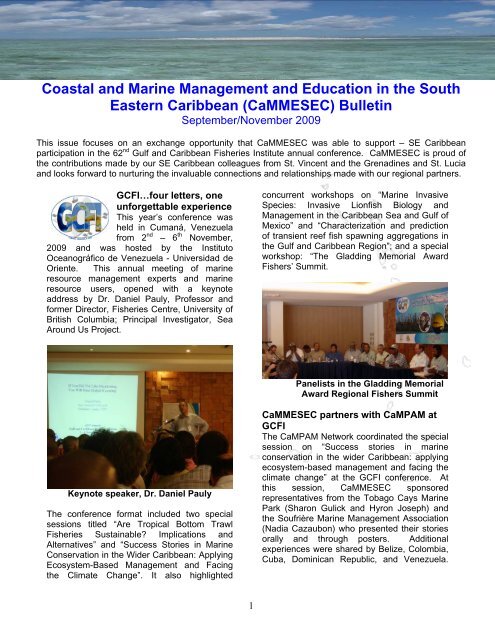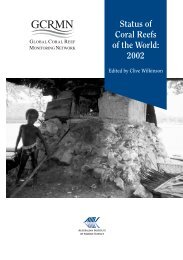(CaMMESEC) Bulletin - International Coral Reef Action Network
(CaMMESEC) Bulletin - International Coral Reef Action Network
(CaMMESEC) Bulletin - International Coral Reef Action Network
- No tags were found...
You also want an ePaper? Increase the reach of your titles
YUMPU automatically turns print PDFs into web optimized ePapers that Google loves.
Coastal and Marine Management and Education in the SouthEastern Caribbean (<strong>CaMMESEC</strong>) <strong>Bulletin</strong>September/November 2009This issue focuses on an exchange opportunity that <strong>CaMMESEC</strong> was able to support – SE Caribbeanparticipation in the 62 nd Gulf and Caribbean Fisheries Institute annual conference. <strong>CaMMESEC</strong> is proud ofthe contributions made by our SE Caribbean colleagues from St. Vincent and the Grenadines and St. Luciaand looks forward to nurturing the invaluable connections and relationships made with our regional partners.GCFI…four letters, oneunforgettable experienceThis year’s conference washeld in Cumaná, Venezuelafrom 2 nd – 6 th November,2009 and was hosted by the InstitutoOceanográfico de Venezuela - Universidad deOriente. This annual meeting of marineresource management experts and marineresource users, opened with a keynoteaddress by Dr. Daniel Pauly, Professor andformer Director, Fisheries Centre, University ofBritish Columbia; Principal Investigator, SeaAround Us Project.concurrent workshops on “Marine InvasiveSpecies: Invasive Lionfish Biology andManagement in the Caribbean Sea and Gulf ofMexico” and “Characterization and predictionof transient reef fish spawning aggregations inthe Gulf and Caribbean Region”; and a specialworkshop: “The Gladding Memorial AwardFishers’ Summit.Panelists in the Gladding MemorialAward Regional Fishers SummitKeynote speaker, Dr. Daniel PaulyThe conference format included two specialsessions titled “Are Tropical Bottom TrawlFisheries Sustainable? Implications andAlternatives” and “Success Stories in MarineConservation in the Wider Caribbean: ApplyingEcosystem-Based Management and Facingthe Climate Change”. It also highlighted<strong>CaMMESEC</strong> partners with CaMPAM atGCFIThe CaMPAM <strong>Network</strong> coordinated the specialsession on “Success stories in marineconservation in the wider Caribbean: applyingecosystem-based management and facing theclimate change” at the GCFI conference. Atthis session, <strong>CaMMESEC</strong> sponsoredrepresentatives from the Tobago Cays MarinePark (Sharon Gulick and Hyron Joseph) andthe Soufrière Marine Management Association(Nadia Cazaubon) who presented their storiesorally and through posters. Additionalexperiences were shared by Belize, Colombia,Cuba, Dominican Republic, and Venezuela.1
Following are highlights from our Vincentianand St. Lucian colleagues’ presentations.Accomplishments and Lessons Learnedfrom the Tobago Cays Marine ParkThe Tobago Cays Marine Park (TCMP),located in St. Vincent and the Grenadines,houses a series of globally significant habitatsincluding coral reefs, sea turtle nesting sitesand feeding areas, and small systems ofmangroves.• the development and endorsement of anew management plan• the establishment of a user fee system• the development of a zoning plan• the authority to enforce the TCMP’sregulations• a doubling of its staff from seven (7) tofifteen (15) which is inclusive of aMarine Biologist• an increase in infrastructure and assetsto include an interpretation centre, anew patrol boat and a garbage facilityon Union IslandAlong with its successes, the TCMP haslearned many a lesson spanning all areas ofmanagement. They note the importance ofstakeholder involvement and communication atall stages of decision making; and the need fora high level of transparency in dialogue withstakeholders as areas they will be seeking toimprove on. Additionally, the TCMP is strivingto improve the systematic collection andanalysis of biological resource data,socioeconomic data of the various users, andenforcement data that will inform TCMPmanagement’s decision making.Aerial view of the Tobago Cays Marine ParkThe marine portion of the park (95% of thepark’s total 66km 2 area) surrounds fiveuninhabited cays, the island of Mayreau (est.population 280), and three islets.This precious gem has been protected since1987 but did not recognise many of theadvances in management effectiveness andstaff and stakeholder capacity until 2006, oneyear after being selected as an OPAAL 1demonstration project site. Under OPAAL, theTCMP received resources for and technicalassistance in strengthening protected areamanagement, the development of sustainablelivelihood opportunities, and capacity building.As a result, the Park can now boast of1 the Organization of Eastern Caribbean States (OECS)Protected Areas and Associated Livelihoods (OPAAL)projectExperience brings wisdom to guide the pathforward and the Tobago Cays Marine Park ismoving full steam ahead.The Helen of the West: A beacon ofMarine management Success…SimplySuccessful!For many of us within the Caribbean, and morespecifically within marine science andeducation, the Soufrière Marine ManagementArea (SMMA) and effective co-managementhave become synonymous. The SMMA’ssuccesses stand tall on the pillars of Comanagement,Science, Sustainability andInstitutional Arrangements.The early years saw a very involved multistakeholderconsultation process whichgenerated a sense of ownership. This led to avery stakeholder centric user based zonationplan, where the related user was given prioritywithin each zone. The spatial separation of the2
different users proved to be pivotal in reducinguser conflict.• has trained its Marine Park Rangers asSpecial Police Constables with thepower to arrest those in contraventionof the SMMA’s rules and regulations• has become self sustaining since 1998through successful implementation ofuser fees, for provision of mooring andanchorage services, dive fees andrelated services, which accounts for90% of the operational costsThe SMMA has seen the spill over effect ofthese services and has recorded an increasein mega yacht arrivals and other tourismrelated activities. This has resulted in a bloomof economic activities for the businesses inSoufrière.Zonation map for the SMMAThe Soufrière Marine Management Associationfurthered their commitment to the communityand the stakeholders by training displacedfishermen in alternative fishing techniques andimplementing a buy back system where byfishermen with destructive fishing gear such asgillnets were compensated for their investmentin fishing gear.Empirical data was also central to the successthat emanated from the process. The constantfish stock assessments from 1995-2001 by Dr.Callum Roberts and his research teamchurned out such validation. His researchresults indicated that fish stock doubled inFishing Priority Areas and tripled in the MarineReserves. This finding was also endorsed bythe fishermen who went on record stating thatthey were catching more and larger fish andthat fish species had “returned”.To date the SMMA• has been made a Local fisheriesmanagement Area and Authority• has the mandate to enforce therelevant laws and regulation under thelocal Fisheries ActThe SMMA sparks a flame of pride within theCaribbean. It has, through many trials,triumphed against the odds, much to thebenefit of the marine environment and thecommunity. It remains a beacon hailing fromthe west; a guide to the region and even theworld.GIS: the new wrench in Marine ParkManagement’s Tool BoxChereceWallace-Haywood (left)and Juel Paul(right) both ofthe Buccoo<strong>Reef</strong> Trust inTobagocontributed tothe posterpresentations at the 62 nd GCFI conference.Cherece chronicles her experience as shesheds light on the potential for GIS in marinepark management.“The 62 nd GCFI Conference, Cumaná,Venezuela, was really an educational and eyeopeningexperience for me. The sessionswere thought provoking and the attendeeswere quite friendly and knowledgeable. At theconference, we the Geographical InformationSystems (GIS) officers of GEF-Integrating3
Watershed and Coastal Area Management /Buccoo <strong>Reef</strong> Trust, Tobago presented a posterentitled, “Utilizing Three-Dimensional OceanModel Maps of Buccoo <strong>Reef</strong> Tobago, forMarine Park Management.”The poster explains how Marine ParkManagers can now use advanced threedimensionaltopographic models of the Buccoo<strong>Reef</strong> to make routine planning andmanagement decisions. The study was used toanalyze the best locations for snorkel trails,reef balls, a boat channel and the extension ofthe existing marine park boundary based onthe 3D model. All these factors can helpminimize the boat and visitor traffic, divert userimpact / traffic to other areas based onobserved reef activity and coral survey data,and also to encourage safety by the use of ademarked boat channel to be used as amitigating force. Many participants werefascinated by methods used to help in MarinePark Management and stimulated interest asto how GIS can be used in their own MarineProtected Areas. This was my first GCFIexperience and is without question, one of themost fascinating conferences I ever attended.”Soufrière Fishermens Cooperative SeesSustainable Fishing as a MustWe break the trend abit, and offer you aninterview with JulianAlexis, Manager of theSoufrière FishermensCooperative. Enjoy ashe goes through thehistory of thecooperative, its involvement with the SMMAand his experience at GCFI.<strong>CaMMESEC</strong>: What is the name of yourorganization?Alexis: Soufrière Fishermens CooperativeSociety Ltd.<strong>CaMMESEC</strong>: How long has the Cooperativebeen in existence?Alexis: The Cooperative was registered in1977.<strong>CaMMESEC</strong>: Were you involved with theCooperative from the start?Alexis: I came in 1979, 30 years ago. I startedas a gas attendant with the cooperative…andI’m now the manager.<strong>CaMMESEC</strong>: How long have you held yourcurrent position?Alexis: 20 years.<strong>CaMMESEC</strong>: How many members are there inthe Cooperative?Alexis: 103 members and a board of directorsof 8. I report directly to the board and carry outtheir directives.<strong>CaMMESEC</strong>: What type of fishing is carriedout by Cooperative members?Alexis: Deep water fishing; seine fishing,including fillet fish nets for surface fish, seinenets for mid-water; and bonito seines for bigfish; pot fishing; and flying fish which is themain income earner.<strong>CaMMESEC</strong>: What services does theCooperative provide for its members?Alexis: We provide ice for fishermen and binsfor storing their catch. We have a scholarshipfund to support two children/ year to attendprimary and secondary school; we donate icefor community activities; we have a death fundto support members’ families; we have adistress fund if a fisherman gets injured; andwe support fishermen when cash from salesare not directly available. We also work withagencies to provide training that would enablefishermen to better sell their fish. For examplewe’ve had training in general food handlingand customer service. Some of the things thecooperative wants to do next year are trainingsin fish handling, safety at sea and navigation.<strong>CaMMESEC</strong>: What benefits do membersderive from being in the Cooperative?Alexis: They have gotten patronage refundevery year for the last 15 years. There is nofixed percentage but it is based on profits anddecided at the AGM. Based on this year’sprofits members will get 5%. They also get apercentage of the shares. This year 7% was4
paid on shares. 2008 profits wereapproximately EC$75,000 as opposed2007which was EC$56,000. Our assets are overEC$3.25M.<strong>CaMMESEC</strong>: What was the Cooperative’sinvolvement in the creation of the SoufrièreMarine Management Area (SMMA)?Alexis: We were involved in consultations fordevelopment of SMMA.<strong>CaMMESEC</strong>: What role does the Cooperativeplay in the management of the SMMA?Alexis: We have a representative on theBoard.<strong>CaMMESEC</strong>: What has been the impact of theestablishment of the SMMA on the fisheries ofthe Soufrière area?Alexis: Very recently we’ve been seeingincreases in mackerel. The corals arerejuvenating and supporting reef fish.<strong>CaMMESEC</strong>: How does SMMA support thefishermen?Alexis: SMMA has fishing priority areas,multiuse area, and no take areas. There wereconflicts between fishermen and tourism soSMMA was set up to address this.<strong>CaMMESEC</strong>: Is this your first GCFI meeting?Alexis: Yes!<strong>CaMMESEC</strong>: What were some of thehighlights of the conference for you?Alexis: I learned a lot about lionfish; didn’tthink that fish were so endangered globally. Iwant to discuss how we do sustainable fishing;we have to be more responsible to theenvironment. I know that there are fishermen[back home] that will not accept this but theymust try. If fishing continues as is the fisherymight collapse.<strong>CaMMESEC</strong>: Have you been able to establishany relationships that you will nurture whenyou return to St. Lucia?Alexis: I got some good contacts, emailcontacts. Every fisherman should be sharingtheir email addresses ‘cause there areexperiences that can be shared. I want tohave an exchange with Grenada to see theirlong line fishery.<strong>CaMMESEC</strong>: How will the Caribbean <strong>Network</strong>of Fisherfolk Organisations benefit theCooperative?Alexis: The umbrella fishermens association inSt. Lucia is part of the Caribbean <strong>Network</strong> ofFisherfolk Organisations for a little over a yearand the Cooperative will benefit from varioustrainings offered. Also my presence here [atthe conference] will now strengthen that link.<strong>CaMMESEC</strong>: What does St. Lucia need to doto ensure the longevity of fishing?Alexis: They need to have more reserves andFish Attracting Devices (FADs) but also haveright equipment to target the correct size offish.Alexis: [GCFI] was a wonderful experience,meeting scientists and other fishers from theregion. Thank you <strong>CaMMESEC</strong> for sponsoringme!For more information contact:Hyacinth Armstrong, Project Coordinator(h.armstrong@buccooreef.org)Todd Denoon, Asst. Project Coordinator(t.denoon@buccooreef.org)Phone: (868) 635-2000;Fax: (868) 639-7333;www.buccooreef.org/icran.html5
















